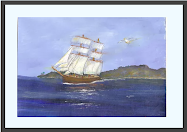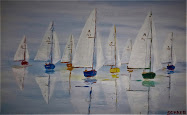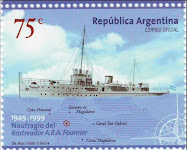Vito Dumas: Detalles de sus Hazañas y Vida
Vito
Dumas: A Life of Nautical Feats
Early Life and Initial Achievements
Beginnings
and First Endeavors Vito Dumas was born on September 26, 1900, in the Palermo neighborhood
of Buenos Aires. From a young age, he dedicated himself to swimming and
athletics, excelling particularly in the former. He undertook notable swims,
such as connecting Núñez and Tigre by swimming, and attempted to cross the Río
de la Plata, setting a record for time spent in the water, although he did not
complete the crossing.
Teaching
Career and Preparations Dumas taught swimming at the Gimnasia y Esgrima Club and other
institutions while seeking new feats to accomplish. In 1931, he traveled to
Europe to attempt the English Channel crossing, but the high costs of support
vessels prevented him from completing the journey. Undeterred, he went to
Arcachón, France, where he found and restored a dilapidated 1912 sailboat,
which he named Lehg I.
The Atlantic Crossing (1931-1932)
Preparations
and Departure On
December 13, 1931, Dumas departed from Arcachón, France, heading for the Canary
Islands. After reaching the Canary Islands, he set sail for South America,
facing harsh conditions along the way.
Challenges
at Sea He steered for 16
hours a day, enduring cold and rain. At times, dolphins accompanied him. After
more than three months of sailing, he arrived in Buenos Aires on April 13,
1932, covering 7,000 nautical miles in 74 days, setting a world record for a
solo sailor. This achievement solidified his reputation as a notable navigator.
The Solo Circumnavigation (1942-1943)
Preparations
and Departure In
1942, amid World War II, Dumas set out to circumnavigate the globe solo. He
built a new sailboat, Lehg II, and departed Buenos Aires on June 27, 1942.
First
Leg: Buenos Aires to Cape Town The first stop was in Montevideo, from where he sailed to Cape Town,
South Africa, crossing the Atlantic. He faced severe storms and, at one point,
his sailboat got trapped between two sleeping whales.
Second
Leg: Cape Town to New Zealand From Cape Town, he crossed the Indian Ocean, reaching New Zealand in
104 days. The sea conditions were extremely challenging, but Dumas persevered.
Third
Leg: New Zealand to Valparaíso From New Zealand, he sailed to Valparaíso, Chile, overcoming
significant challenges during this leg as well.
Fourth
Leg: Valparaíso to Buenos Aires Finally, from Valparaíso, he crossed Cape Horn and reached Mar del
Plata. After a rest, he sailed to Montevideo and then back to Buenos Aires.
Publications Many of his
experiences were recorded in his books "Alone, Heading for the Southern
Cross" and "The Roaring Forties," where he recounted his
adventures and challenges.
Subsequent Attempts and Retirement
Trips
to the United States After his circumnavigation, Dumas attempted to travel to the United
States twice, one of them in 1946. In one notable voyage, he sailed from Buenos
Aires to New York but faced numerous challenges, including a lack of provisions
and water.
Last
Attempt in 1955 In
1955, he made his final attempt at a significant voyage but was unsuccessful.
From then on, he retired from active sailing, dedicating himself to painting
and enjoying a more tranquil life.
Death and Legacy
Death Vito Dumas passed
away on March 28, 1965, at his home in Olivos, due to a stroke. His death was
widely covered by the press, highlighting his adventurous life and legacy as
one of the great solo sailors.
Posthumous
Recognitions In
1992, his son Vito Diego Dumas visited the Museum of Transport in Luján, where
the Lehg I was on display. The family contributed materials to restore and
maintain the boat in optimal conditions for future generations. His legacy
remains a source of inspiration for sailors and adventurers worldwide.
Media Coverage
Coverage
in La Nación The
newspaper "La Nación" described his death as the end of a symbol of
romanticism and audacity in sports, emphasizing his adventurous spirit and
ability to face the sea's challenges.
Remembrance
and Tributes
Dumas is remembered as one of the last romantics in sports, a symbol of
audacity, courage, and determination. His life and feats continue to inspire
new generations of sailors and sea lovers.
Conclusion
Vito Dumas' life is a
testament to perseverance and courage. His achievements in solo sailing and his
indomitable spirit make him an iconic figure in maritime history, whose legacy
endures in the collective memory and the hearts of those who value audacity and
adventure.



.jpg)










1 comentario:
Guillermo,
Cuales son las condiciones de visitación en el momento de Legh I e Legh II? Voy a estar en Buenos Aires en los dias 17, 18,19 y tenía planes de conocerlos. Gracias
Paulo Baptista
Brasil
Publicar un comentario